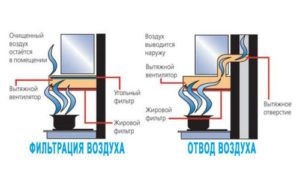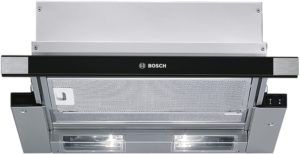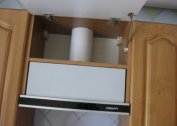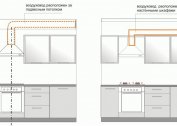Today, almost every kitchen has a hood. Thanks to this device, the products of burning fats and fumes do not settle on walls, furniture and windows. Until recently, all the discharge was brought out through the ventilation system. But a few years ago a new model appeared on the market - a hood without a duct.
To install such devices, you do not need to make a ventilation hole, which is very convenient for owners of apartments and houses who do not want to block the ventilation course.
Principle of operation
An extractor hood to the kitchen without an air duct is equipped with a motor that drives the fan and includes cleaning units. Thanks to the fan, traction is formed in the system, which helps to absorb harmful fumes from the kitchen.
Most modern models can work in several modes - exhaust and circulation. Each of these modes directs polluted air to different places.
Exhaust mode drives the air to the ventilation shaft or to the street. This is achieved thanks to special clamps connecting the duct.
The operation of the circulation mode is to clean the dirty air and return it to the room.
Views
What are the types of hoods without a duct? Currently, manufacturers produce flat and built-in models.
The latter look very neat in the kitchen and take up a minimum of space. The built-in range hood can easily be disguised as a wall cabinet or panel. In addition, there are retractable built-in devices that are cleaned after use, freeing up space in the kitchen.
Flat hoods include a body panel, fan and filters. These models are also compact in size and fit into the space of even the smallest kitchen.
Benefits of hoods without duct
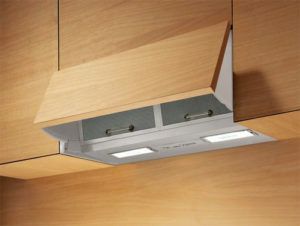 Despite the fact that many people consider the most effective devices that remove vapors from the room to the street, kitchen hoods without ducts have a number of useful advantages.
Despite the fact that many people consider the most effective devices that remove vapors from the room to the street, kitchen hoods without ducts have a number of useful advantages.
- During the operation of the device connected to the duct, everything works relatively normally. But it should be borne in mind that ventilation systems are designed for a certain load, exceeding which significantly deteriorates the quality of ventilation. When the in-line kitchen hood is turned off, the natural exchange of air ceases due to the air duct blocking the ventilation duct. Therefore, the flow hood adversely affects the quality of the ventilation system, reducing its efficiency at least twice. A kitchen hood without a duct does not create such problems, it simply recirculates the air in the process. And when it is turned off, the natural air exchange planned during the construction of the house is not disturbed. This is the main plus of models of this type.
- The second advantage is the ease of construction. It does not include massive pipes that clutter the space of the room. A kitchen hood without a duct is a compact, flat surface that is horizontal to the floor. Such models do not overload the wall with their weight and do not spoil the interior of the kitchen.
- Another plus is a fairly simple installation. To install the structure, you just need to fix it on the wall using household tools, and connect the plug to the outlet.
- The advantage of the hood is also considered a very simple replacement and maintenance of filters. These designs are equipped with two types of filters.As a rule, coarse filters are made of metal, which makes them easy to care for. Wash filters with non-abrasive detergents manually or using a dishwasher. If carbon filters become clogged, old filters are thrown away and new ones are installed.
- The undoubted advantage of the hoods without duct is their price. Such models are much cheaper compared to conventional designs. In addition, any man who does not have special skills can install a recirculation hood: for this, it is enough to simply make mounting holes in the wall and fix the device.
- Contrary to the widespread belief that flow models purify air much better, recirculation models also do their job perfectly. The main thing is to properly care for the device and change filters in time.
disadvantages
- In kitchen hoods without ducts, there are carbon filters that cannot be cleaned after contamination. Therefore, they must be periodically replaced with new ones, which leads to additional costs. However, many are interested in the question: how long does one carbon filter last? In fact, its service life depends on many factors: this is the number of people in the family, and the frequency of use of the hood. In addition, with frequent cooking of greasy fried foods, filters become soiled faster. On average, one filter is enough for 3-6 months. However, some modern models of in-line hoods are also equipped with filters that require periodic replacement.
- Manufacturers of hoods without an air duct produce them in a small design variety. Most often, they have noble simple forms and laconic images, while flowing models are made in a variety of options: from the most modest to luxurious mantelpieces.
How to choose?
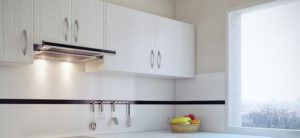 For a new hood without an air duct to please its owners for a long time, you need to know how to choose the right model that suits you. Today on sale you can find models that differ in design, size, type of installation and additional functions. The simplest hoods have built-in lighting and a speed selector. More expensive options may come with sensors that automatically turn the hood on or off. Luxury devices are able to respond to changes in air humidity and temperature, independently selecting the desired mode of operation. Filters in these models are equipped with indicators that indicate pollution. Also included with some hoods is a control panel, thanks to which the device can be controlled from anywhere in the kitchen.
For a new hood without an air duct to please its owners for a long time, you need to know how to choose the right model that suits you. Today on sale you can find models that differ in design, size, type of installation and additional functions. The simplest hoods have built-in lighting and a speed selector. More expensive options may come with sensors that automatically turn the hood on or off. Luxury devices are able to respond to changes in air humidity and temperature, independently selecting the desired mode of operation. Filters in these models are equipped with indicators that indicate pollution. Also included with some hoods is a control panel, thanks to which the device can be controlled from anywhere in the kitchen.
Selection tips
- Choosing a particular model, you need to pay attention to its performance. To do this, multiply the area of the room by its height, and multiply the result by 12 (SES norm for updating kitchen air).
- Larger devices are best avoided as they work more noisily than small ones. In addition, a large hood will consume more electricity, which will entail undesirable additional costs.
- To choose the quietest model, you should pay attention to the noise indicators indicated in the instructions. The smallest noise level is characterized by a figure of 40 dB.
- It is best to choose a device with a wide range of adjustments. This will allow you to more accurately adjust the operation of the hood.
- Before buying a particular device, it is advisable to familiarize yourself with the reviews and recommendations of people who already use such models. It should also be borne in mind that a low price will save money for a short period of time, and after some time a cheap hood can often fail, requiring constant repairs or even a complete replacement.
Most popular brands
At present, many manufacturers offer hoods without an air duct. By choosing one of the leading brands, you can ensure the smooth operation of equipment for a relatively low cost.
- Ariston is a well-known manufacturer that has been manufacturing various types of equipment for 15 years. Hoods of this company have proven themselves on the good side.
- "Integra" - is also a fairly common brand, qualitatively removing unnecessary fumes in the kitchen. Hoods from this manufacturer are distinguished by high-quality filters that ensure long service life.
- “Zigmund-Shtain” and “Bosch” - German manufacturing companies produce products that have established themselves in the world market as one of the most reliable. Therefore, every housewife can be sure that in her kitchen the air will always be clean and fresh.
Recirculation hoods have proven themselves efficiently and with long service life. In addition, these devices are a unique and simple solution to such a problem as the small size of some rooms and ergonomics.
